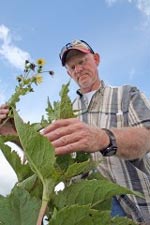
Breeder Sees Cup Plant Potential as Biomass/Carbon Storage Crop

South Dakota State University plant breeder Arvid Boe and his colleagues are looking at cup plant as a possible biomass crop that could store carbon in its root system and add biodiversity to biomass plantings. Photo courtesy of South Dakota State University Research News
South Dakota State University research is exploring a native perennial called cup plant as a potential new biomass crop that could also store carbon in its extensive root system and add biodiversity to biomass plantings.
Researchers are exploring whether cup plant could be grown in low, moist prairies generally unfit for cropland. It would be grown and processed along with native grasses grown for biomass.
“We anticipate down the road there’s going to be a need and maybe even a market for plants that can store carbon under ground and be part of a biomass production system,” SDSU professor Arvid Boe said.
Boe, a plant breeder, is the lead investigator on a grant of $324,336 from the U.S. Department of Energy channeled through the SDSU-based North Central Sun Grant Center. Project goals include:
- studying genetic variation and developing molecular markers in cup plant populations from the eastern Great Plains;
- developing new cultivars that can be grown in combination with other biomass crops;
- determining best practices such as seeding rate, row spacing, harvest timing and nutrient management so that producers will know how to grow the plant;
- determining life histories of insect pests; and
- determining biochemical composition.
Boe said cup plant, or Silphium perfoliatum, is a member of the sunflower family found in moist low ground in the eastern Great Plains, where it can grow more than 7 feet tall. It has large seeds and good seedling vigor, and it yields a lot of biomass.
“It’s conspicuous in the prairie as a very productive forb in a tallgrass prairie where you have your major grasses such as big bluestem, switchgrass and prairie cordgrass,” Boe said. “We haven’t come up with too many things to grow with our grasses to add biodiversity to these biofuel mixtures that we’re anticipating growing down the road. It’s very compatible with such things as switchgrass and prairie cordgrass and big bluestem.”
Boe said scientists don’t envision planting entire fields of cup plant. Instead they view it as one in a mix of biomass species that would be seeded in zones best suited for them, just as in the original tallgrass prairie. Boe and his colleagues — borrowing a term used years ago by conservationist Erling Jacobson of the U.S. Department of Agriculture’s Soil Conservation Service — speak of “sculpting the landscape” with native grasses best suited to different locations in the prairie.
“We don’t necessarily have a mix at any particular area, but we have various species wherever they’re best adapted on the landscape. It doesn’t make any sense for us to have mix switchgrass, big bluestem and prairie cordgrass together and plant it over a whole field. After five years, the species that are best adapted are going to take over anyway in their particular niche,” Boe said.